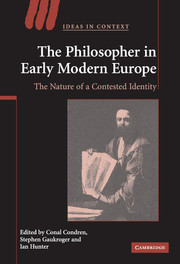Book contents
- Frontmatter
- Contents
- List of contributors
- Acknowledgements
- Introduction
- 1 The persona of the natural philosopher
- 2 The university philosopher in early modern Germany
- 3 The persona of the philosopher and the rhetorics of office in early modern England
- 4 From Sir Thomas More to Robert Burton: the laughing philosopher in the early modern period
- 5 Hobbes, the universities and the history of philosophy
- 6 The judicial persona in historical context: the case of Matthew Hale
- 7 Persona and office: Althusius on the formation of magistrates and councillors
- 8 Descartes as sage: spiritual askesis in Cartesian philosophy
- 9 The natural philosopher and the virtues
- 10 Fictions of a feminine philosophical persona: Christine de Pizan, Margaret Cavendish and philosophia lost
- 11 John Locke and polite philosophy
- Index
- IDEAS IN CONTEXT
11 - John Locke and polite philosophy
Published online by Cambridge University Press: 06 November 2009
- Frontmatter
- Contents
- List of contributors
- Acknowledgements
- Introduction
- 1 The persona of the natural philosopher
- 2 The university philosopher in early modern Germany
- 3 The persona of the philosopher and the rhetorics of office in early modern England
- 4 From Sir Thomas More to Robert Burton: the laughing philosopher in the early modern period
- 5 Hobbes, the universities and the history of philosophy
- 6 The judicial persona in historical context: the case of Matthew Hale
- 7 Persona and office: Althusius on the formation of magistrates and councillors
- 8 Descartes as sage: spiritual askesis in Cartesian philosophy
- 9 The natural philosopher and the virtues
- 10 Fictions of a feminine philosophical persona: Christine de Pizan, Margaret Cavendish and philosophia lost
- 11 John Locke and polite philosophy
- Index
- IDEAS IN CONTEXT
Summary
The inscription on the bust of John Locke in the Temple of British Worthies in Stowe, Buckinghamshire, describes him as the ‘best of all philosophers’. When Voltaire discussed An Essay Concerning Human Understanding (1690) he declared that past thinkers, including René Descartes, had written ‘the Romance of the Soul’, but now ‘a Sage at last arose, who gave, with an Air of the greatest Modesty, the History of it’. Voltaire thus ensured that Locke's reputation extended throughout Europe. However, such fame came only towards the end of his life, because his major works did not begin to appear until 1690. Moreover, although the Essay carried his name (in the first edition only in the dedication, not the title page), the Two Treatises of Government (1690) and A Letter Concerning Toleration (first appearing as Epistola de tolerantia in 1689) were both published anonymously, and not owned by Locke until he bequeathed books to the Bodleian Library in a codicil to his will.
After his death in 1704, Locke's friends and admirers fashioned his status as a philosopher. By sampling these portraits we can see that writers who contributed to the making of his image regarded the identity of the philosopher as one that had to be defined in relation to other identities, offices or commitments. It is useful to distinguish this public identity from the persona that Locke might have struggled to find during his lifetime.
- Type
- Chapter
- Information
- The Philosopher in Early Modern EuropeThe Nature of a Contested Identity, pp. 254 - 275Publisher: Cambridge University PressPrint publication year: 2006
- 1
- Cited by



